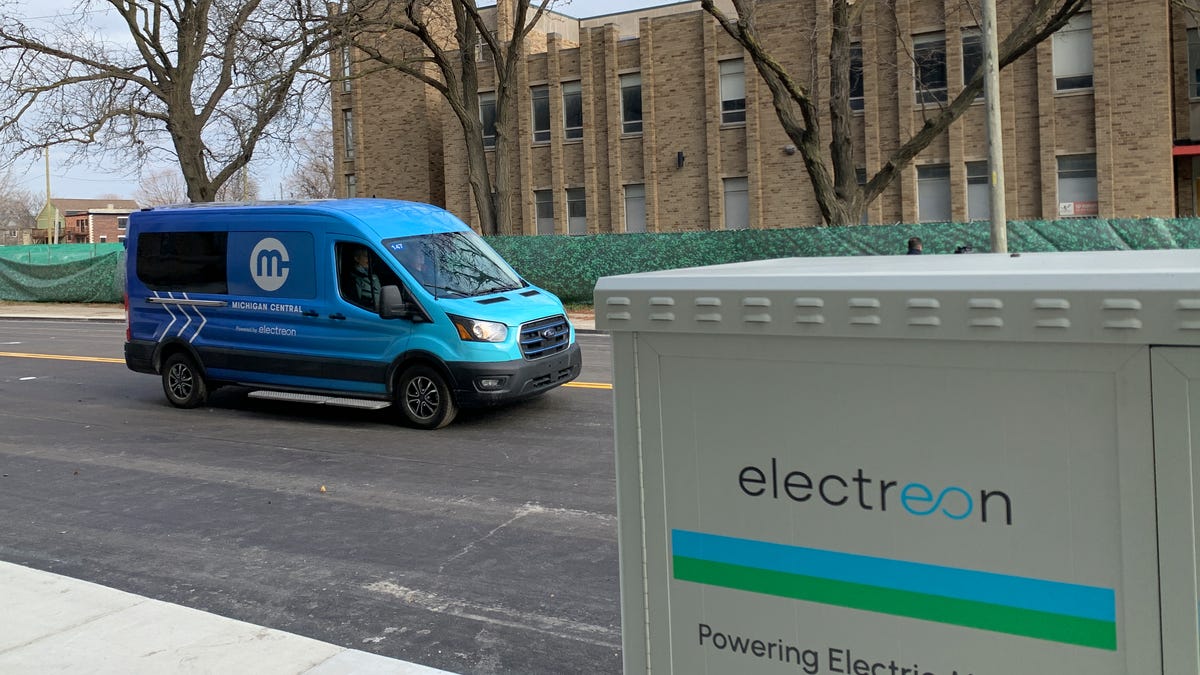The Michigan Transportation Department and city of Detroit on Wednesday opened the segment on 14th Street between Marantette and Dalzelle streets near Michigan Central Station, where Ford Motor Co. is building an electric- and autonomous-vehicle campus. The road is equipped with inductive-charging coils from Israel-based Electreon Wireless Ltd. to test the technology’s efficiency and potential for public transportation opportunities. Only EVs equipped with a special receiver can be charged from it.
Gov. Gretchen Whitmer in September 2021 announced a pilot initiative to develop the nation’s first wireless charging infrastructure on a public road in Michigan. MDOT and Electreon have a five-year agreement to develop an electric-road system to test the technology in the state, including 1 mile in Corktown.
The electric road is safe for drivers, pedestrians and wildlife, according to the project leaders. There are two Electreon static inductive charging stations in front of the Michigan Central Building, which is different from the former train station. The stations can charge parked EVs equipped with receivers.
I still don’t understand the value of this.
Unless they’ve developed some kind of world-changing charger that can charge orders of magnitude faster than anything already available, I fail to see how anyone is going to get a meaningful range boost out of these.
IIRC best wired chargers on the market get you something like 10-20 miles of range for every hour you spend plugged in. I’m not even sure there are EV’S with enough range to truly capitalize on that being mass produced.
This really just seems like a symbolic thing.
I don’t know the stretch of road or have an EV, but my first thought would be sitting at long traffic lights. It may not extend your range, but it might offset a little over regular usage.
My second would be proof of concept. Does this work without impact at a small scale before trying it down a highway.
IIRC best wired chargers on the market get you something like 10-20 miles of range for every hour you spend plugged in.
If you’re talking about “plug-in-and-go”-chargers, which can use any outlet, then yes.
Proof:
I’m using a Nissan Leaf (2022) with a 40 kWh battery and a mid-range of 275 km, according to ev-database.org
A typical European outlet is 110 Volts, with a usual phase output of 16 Amps. Negecting all loss, this gives us 3680 Watts output per outlet, or 3.68 kWh.
This would mean to fully charge this car (in a perfect, no-loss world), would take about 11 hours. This would mean we could charge at a rate of 270 km / 11 hours = 25 km/h (16 mph).
However, a dual, or tri-phase charger can still be installed at home, doubling or tripleing the hypothetical loading potential.
As dual-phase would have 32 Amps and triple-phase even 48 Amps, this would mean you could charge at a maximum of 11.04 kWh (again, without any resistance or loss). This would increase the charging time to a maximum of 75 km/h (46 mph)
Now, I haven’t yet seen triple-phase chargers at homes yet, but dual-phase are increasingly common.
^(Footnote: I started writing this thinking it could not be true and to prove you wrong, but you were correct for the plug-in chargers, which I didn’t expect. Thanks for re-acquainting me with these kinds of maths again, nonetheless 🙂)
Edit: added mph to all km/h calculations, typo




